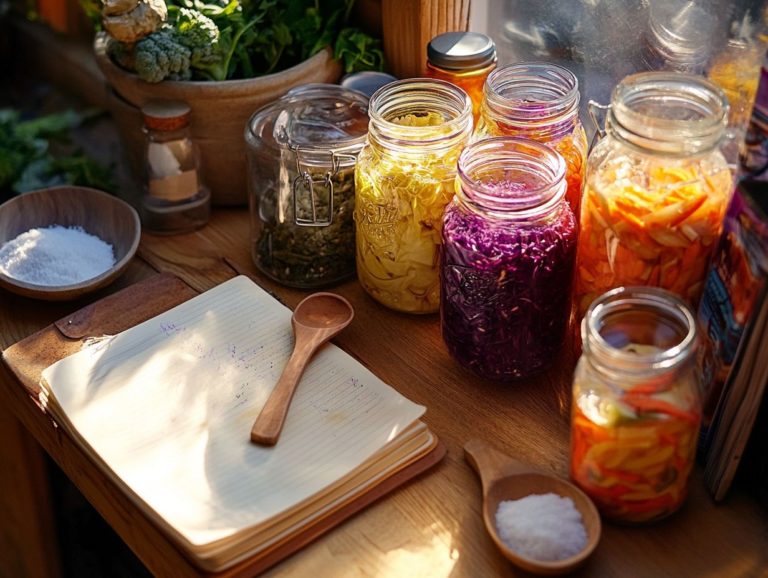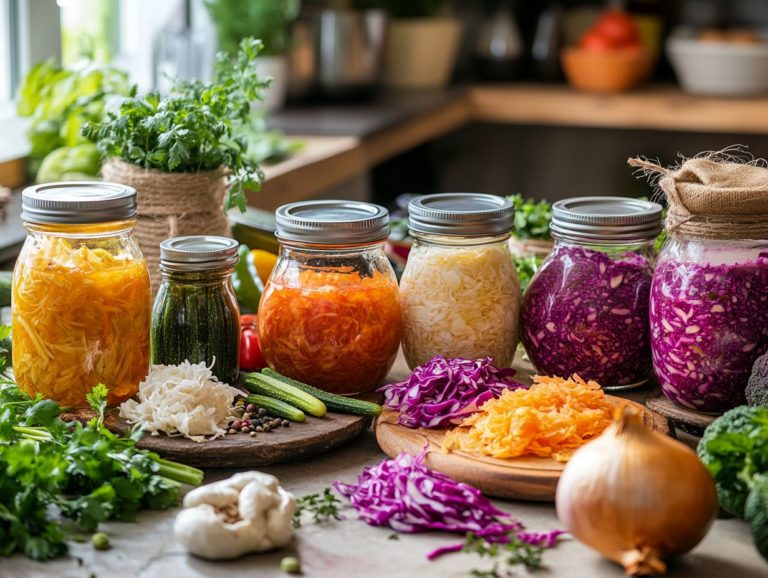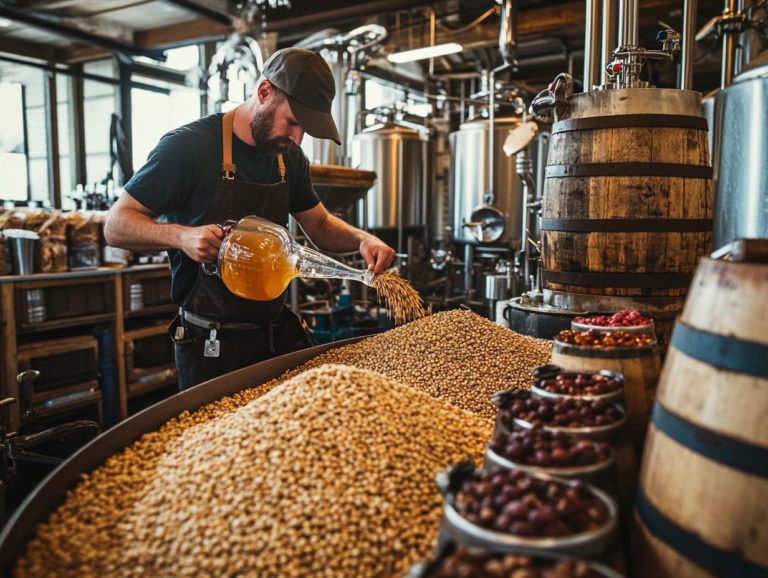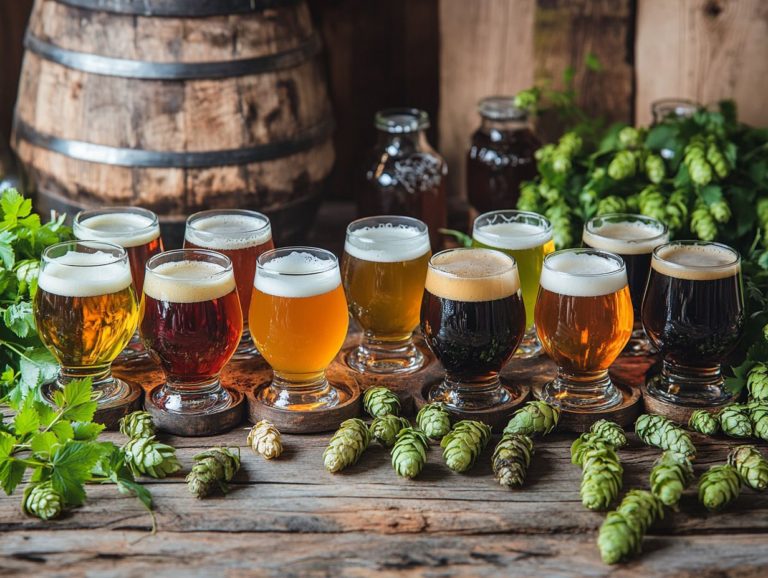The Fermentation Process Explained for Beginners
Fermentation is a captivating and time-honored process that transforms simple ingredients into exquisite foods and beverages, enhancing your culinary adventures. Get ready to dive into our comprehensive guide on fermentation!
From the zesty crunch of sauerkraut to the velvety richness of yogurt, fermentation amplifies flavors and brings a wealth of health benefits to the table.
This guide delves into the science behind fermentation, exploring its diverse types and outlining the essential ingredients and equipment you ll need, such as a fermentation vessel and fermentation weights, to begin your journey.
Whether you re just starting or have some experience, this guide equips you with the knowledge for your own unique fermentation experience, including vegetable and dairy fermentation techniques.
Contents
- Key Takeaways:
- What is Fermentation?
- Why is Fermentation Used?
- What are the Benefits of Fermentation?
- How Does Fermentation Work?
- What are the Key Ingredients for Fermentation?
- What Foods and Drinks Can Be Fermented?
- What is the Fermentation Process for Dairy?
- What is the Fermentation Process for Grains?
- What Equipment is Needed for Fermentation?
- Understanding Fermentation Vessels
- What is a Fermentation Weight?
- How to Start the Fermentation Process?
Key Takeaways:
- Fermentation is a natural process that converts sugars into alcohol, acids, or gases, used to preserve and enhance food and drinks.
- It improves digestion, increases nutrients, and creates unique flavors and textures.
- The essential ingredients include bacteria, yeast, and sugar, along with fermentation vessels and proper temperature control.
What is Fermentation?
Fermentation is a fascinating natural process in which microorganisms, like yeast and bacteria, transform sugars into alcohol or organic acids without oxygen. This transformation creates delightful products such as alcoholic beverages, yogurt, and sourdough bread.
The significance of this process cannot be overstated, as it enhances the nutritional value of these foods and adds depth to their flavor profiles.
To truly grasp the art of fermentation, delve into its rich history, examine the factors that influence it, and familiarize yourself with its various types such as alcoholic fermentation, lactic acid fermentation, acetic acid fermentation, and butyric acid fermentation. Understanding the fermentation timeline and evolution is crucial for grasping its applications and benefits.
Why is Fermentation Used?
Fermentation serves numerous purposes, primarily elevating the flavor, nutritional value, and safety of food products. It also provides a host of health benefits, such as improved digestion and extended shelf life.
This remarkable process not only preserves foods like kimchi and sauerkraut but transforms them into probiotic-rich delights that significantly benefit your gut microbiome. Louis Pasteur’s contributions to fermentation paved the way for safer and more efficient production of these probiotic foods.
Fermentation also plays a vital role in crafting a variety of beverages, including wine, beer, and kombucha. These beverages are imbued with unique flavors and health-boosting properties that enhance your overall well-being. Understanding the fermentation chemistry and microbiology behind these processes can help you optimize the quality of these fermented products.
What are the Benefits of Fermentation?
The benefits of fermentation go far beyond simple preservation. They present a wealth of health advantages that you can truly appreciate. Improved digestion and a thriving gut microbiome are just a few of the perks.
When you indulge in fermented foods like yogurt, kimchi, and kefir, you re not just treating your palate. You re also enriching your body with probiotics that bolster immune function and overall well-being. These foods are rich in organic compounds that enhance gut health and nutrient absorption.
This remarkable process aids digestion and fosters a diverse and balanced gut microbiome, essential for your optimal health. By incorporating fermented products into your diet, you invite beneficial bacteria into your digestive system. This paves the way for enhanced nutrient absorption and a more robust immune response.
Unlock the extensive health benefits of fermented foods by adding them to your diet today! The fermentation process can also produce vital vitamins, such as B vitamins and vitamin K2, further elevating your health.
With ongoing research shedding light on the link between fermented foods and mental health, it s becoming increasingly clear that gut health plays a significant role in influencing mood and cognitive function. Embracing fermentation could very well be a key to unlocking your well-being on multiple levels.
How Does Fermentation Work?
The fermentation process is a fascinating biological phenomenon. It unfolds when microorganisms, including yeast and bacteria, convert sugars and other carbohydrates into alcohol or organic acids through processes that occur without oxygen. This intricate chemical process forms the foundation of many fermentation applications, from food preservation to alcohol production.
This transformation encompasses various fermentation methods and is shaped by factors such as temperature, time, and the specific microorganisms employed. Grasping the principles of fermentation chemistry and microbiology is crucial to optimize fermentation outcomes and craft high-quality fermented products.
What are the Key Ingredients for Fermentation?
Key ingredients for fermentation include a variety of microorganisms, such as yeast and bacteria, paired with substrates like glucose. These serve as the primary energy source for these organisms. The introduction of brine in vegetable fermentation, along with specific fermentation cultures, can profoundly impact the flavor and quality of the final product.
Your choice of ingredients plays a pivotal role in successfully initiating the fermentation process. It helps achieve the desired flavor profiles and health benefits from the fermented foods. The right fermentation steps and techniques can lead to remarkable results.
Consider lactic acid bacteria, frequently utilized in the production of sourdough bread and yogurt. They metabolize sugars to produce lactic acid, enhancing flavor and preserving the food. In vegetable fermentation, a brine solution made of salt and water fosters an environment that promotes beneficial organisms while keeping spoilage bacteria at bay.
Striking this balance is crucial, as the concentration of salt directly influences the fermentation rate and overall taste.
Each fermentation culture you select can impart distinct characteristics. This showcases the artistic synergy between ingredients and techniques that culminate in high-quality fermented products. By following a reliable fermentation recipe, you can ensure consistency and quality in your ferments.
Different Types of Fermentation
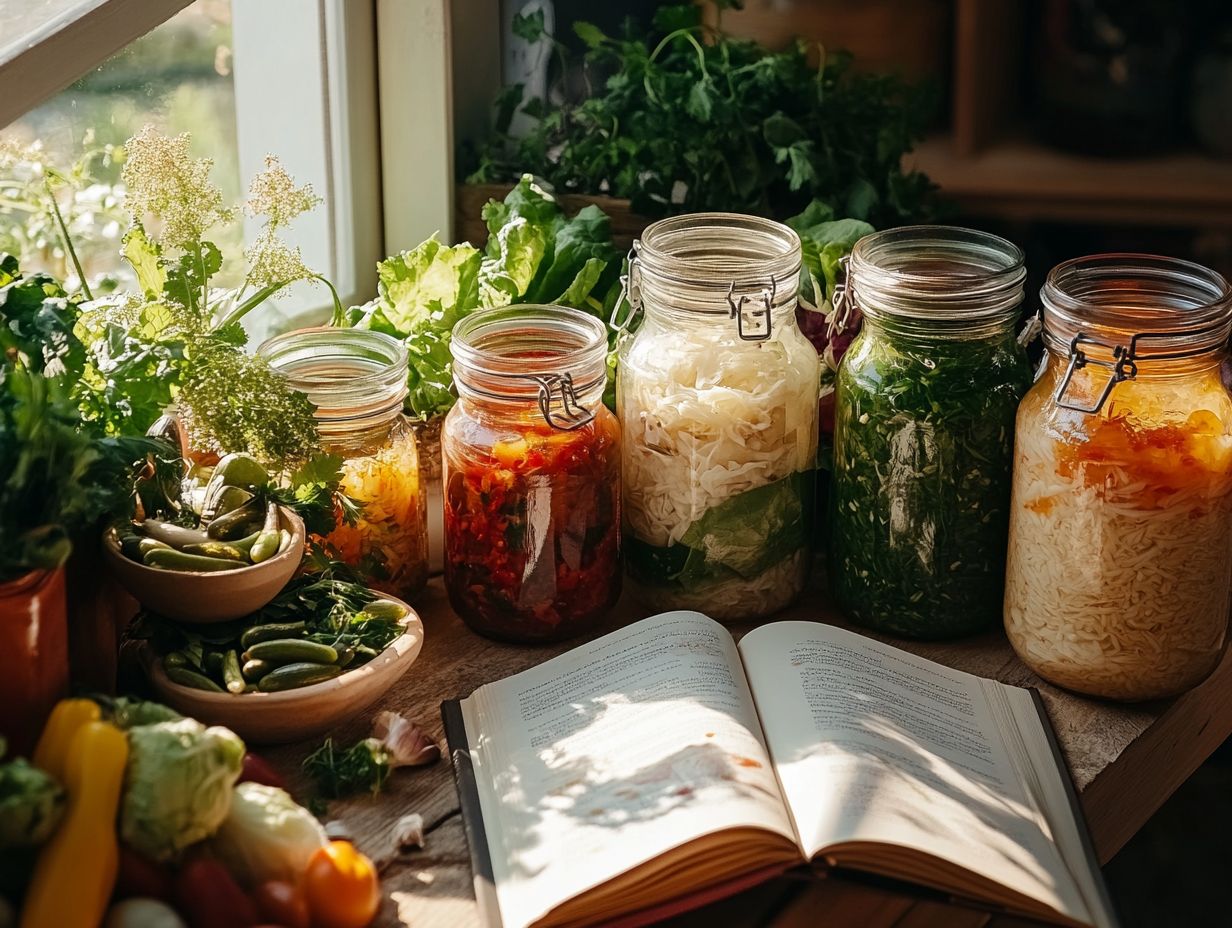
Different types of fermentation await your exploration, each with its own fascinating transformation. Take alcoholic fermentation, for example, where sugars are converted into ethanol and carbon dioxide. Then there s lactic acid fermentation, producing lactic acid as its main byproduct. Acetic acid fermentation creates that tangy vinegar you might use in your dressings, while butyric acid fermentation is the culprit behind those occasionally rancid flavors in certain foods.
Each fermentation type is defined by specific microorganisms; think yeast for alcoholic fermentation and Lactobacillus for lactic acid fermentation. Together, they play pivotal roles in food production and preservation.
Alcoholic fermentation is your go-to process when brewing beer or crafting wine, with yeasts like Saccharomyces cerevisiae doing the heavy lifting. Lactic acid fermentation is essential for creating yogurt and those deliciously tangy fermented vegetables, relying on a variety of Lactobacillus and Streptococcus strains. On the other hand, acetic acid fermentation is crucial for producing vinegar, employing Acetobacter species to transform ethanol into acetic acid.
While butyric acid fermentation might not win any popularity contests due to its off-flavors, it still finds a place in fermented dairy products, thanks to Clostridium bacteria.
These fermentation processes enhance flavors and textures. They also improve food preservation, nutritional value, and digestibility, making your culinary adventures all the more rewarding. With proper fermentation factors and methods, you can master the art of creating extraordinary fermented foods and beverages.
What Foods and Drinks Can Be Fermented?
You can explore a remarkable array of foods and beverages that can be fermented, ranging from beloved staples like yogurt, kombucha, kimchi, and sauerkraut to delightful drinks such as wine and beer.
The fermentation process elevates these ingredients, transforming them into flavorful products that boast enhanced nutritional value and unique textures. The use of glucose as a primary substrate in these processes highlights the scientific principles behind fermentation.
Consider the culinary diversity offered by other fermented delights like miso, tempeh, and kefir, each showcasing its own distinct flavors and health benefits. This exciting tapestry of fermentation transforms your culinary experience into something extraordinary!
What is the Fermentation Process for Vegetables?
The fermentation process for vegetables begins with preparing a brine solution and fully submerging the vegetables to create an oxygen-free environment. This allows lactobacillus bacteria to flourish and ferment the natural sugars found in the vegetables. Not only does this process preserve their freshness, but it also enhances their flavors and boosts nutritional value, leading to beloved products like sauerkraut and kimchi. To achieve successful vegetable fermentation, meticulous attention to each step and strict hygiene practices are essential.
To start, you’ll want to select fresh, high-quality vegetables. Wash them thoroughly to eliminate any dirt or contaminants. The brine solution, typically a blend of water and salt, should be mixed in precise proportions to cultivate the perfect fermentation environment. Once you submerge the vegetables in the brine, it’s crucial to monitor them regularly keep an eye out for signs of active fermentation, like bubbling, and take a moment to taste for the desired level of sourness.
Remember, the cleanliness of your utensils and containers is paramount; introducing unwanted bacteria can quickly spoil your batch. Consider popular choices for fermentation such as cucumbers, carrots, and radishes each can develop a unique and delightful flavor when fermented just right. Additionally, fermented foods like kimchi and sauerkraut are also excellent options to explore.
Start your fermentation journey today and discover the amazing flavors waiting for you!
What is the Fermentation Process for Dairy?
Dairy fermentation is an art that transforms lactose in milk into lactic acid using specific bacteria or cultures. This process gives rise to delightful products like yogurt and kefir. Known as lactic acid fermentation, it involves bacteria such as Lactobacillus. Not only are these treats delicious, but they also offer numerous health benefits, including improved gut microbiome and enhanced lactose tolerance.
The fermentation process for dairy products varies depending on what you’re making, but it typically involves several key steps:
- Pasteurization – Heating the milk to eliminate harmful bacteria.
- Inoculation with fermentation cultures – Introducing specific bacteria or cultures to start fermentation.
- Incubation – Allowing the mixture to ferment at a controlled temperature.
- Cooling to stop the fermentation – Lowering the temperature to halt the process.
This careful approach is part of a broader category known as fermentation techniques. It ensures that desired flavors and textures develop while enhancing the nutritional profile of the dairy.
The fermentation cultures often feature beneficial strains such as Lactobacillus bulgaricus and Streptococcus thermophilus. These cultures diligently convert lactose into lactic acid, thickening the dairy and acting as a natural preservative.
What do you get from this process? A diverse array of fermented dairy products that are easier to digest and packed with probiotics. These promote gut health and improve lactose tolerance.
Around the world, people enjoy these products, weaving them into traditional dishes ranging from Indian lassi to Greek tzatziki. This showcases the versatility and culinary significance of fermented dairy.
The health benefits tied to these foods like improved digestion and enhanced immune function underscore their essential role in a balanced diet.
What is the Fermentation Process for Grains?
The fermentation process for grains typically involves soaking, cooking, or sprouting them. This encourages beneficial microorganisms to flourish, transforming grains into delightful products like miso, tempeh, and even kombucha.
This meticulous process enriches the flavor profile of grains while enhancing their digestibility and nutritional value, making them more appealing for your enjoyment.
Various fermentation techniques, particularly the use of specific starter cultures, play a crucial role in shaping the quality and characteristics of the final product. The involvement of bacteria, yeasts, and other microorganisms is essential for successful fermentation.
After soaking the grains, you often cook them to a precise consistency, preparing them for the fermentation journey ahead. Once cooled, introducing starter cultures living microorganisms specifically chosen for the type of fermentation encourages the growth of beneficial bacteria and yeasts. This process, performed without oxygen, is critical for the success of many fermentation methods.
This careful cultivation contributes to a distinctive taste and elevates the nutritional value, delivering health benefits such as improved gut health and enhanced vitamin availability.
In the culinary world, you ll find numerous applications for these fermented grains. From the comforting bowl of savory miso soup from Japan to hearty Indonesian tempeh stir-fries and a variety of sourdough breads, fermentation history shows these foods have been staples in various cultures due to their nutritional value and fermentation benefits.
Each dish beautifully illustrates the versatility and nutritional prowess of fermented grain products, enriching both your diet and your palate.
What Equipment is Needed for Fermentation?
To engage in fermentation successfully, you’ll need specific equipment essential to the process. A fermentation vessel, fermentation weights, and a fermentation lid work together to create the ideal environment for fermentation.
Understanding the basic principles of fermentation chemistry can enhance your process even further. These tools play a crucial role in maintaining conditions without oxygen, preventing contamination, and allowing for proper gas release. All of this ensures that fermentation unfolds seamlessly.
Grasping the role of each piece of equipment is vital for both novices and seasoned fermenters, as it directly impacts your ability to produce high-quality fermented foods.
What are your favorite fermented dishes? Exploring fermentation can add a whole new dimension to your culinary skills!
In summary, the fermentation process enhances the flavor, digestibility, and nutritional benefits of both dairy and grains, making these foods a valuable addition to any diet.
Understanding Fermentation Vessels
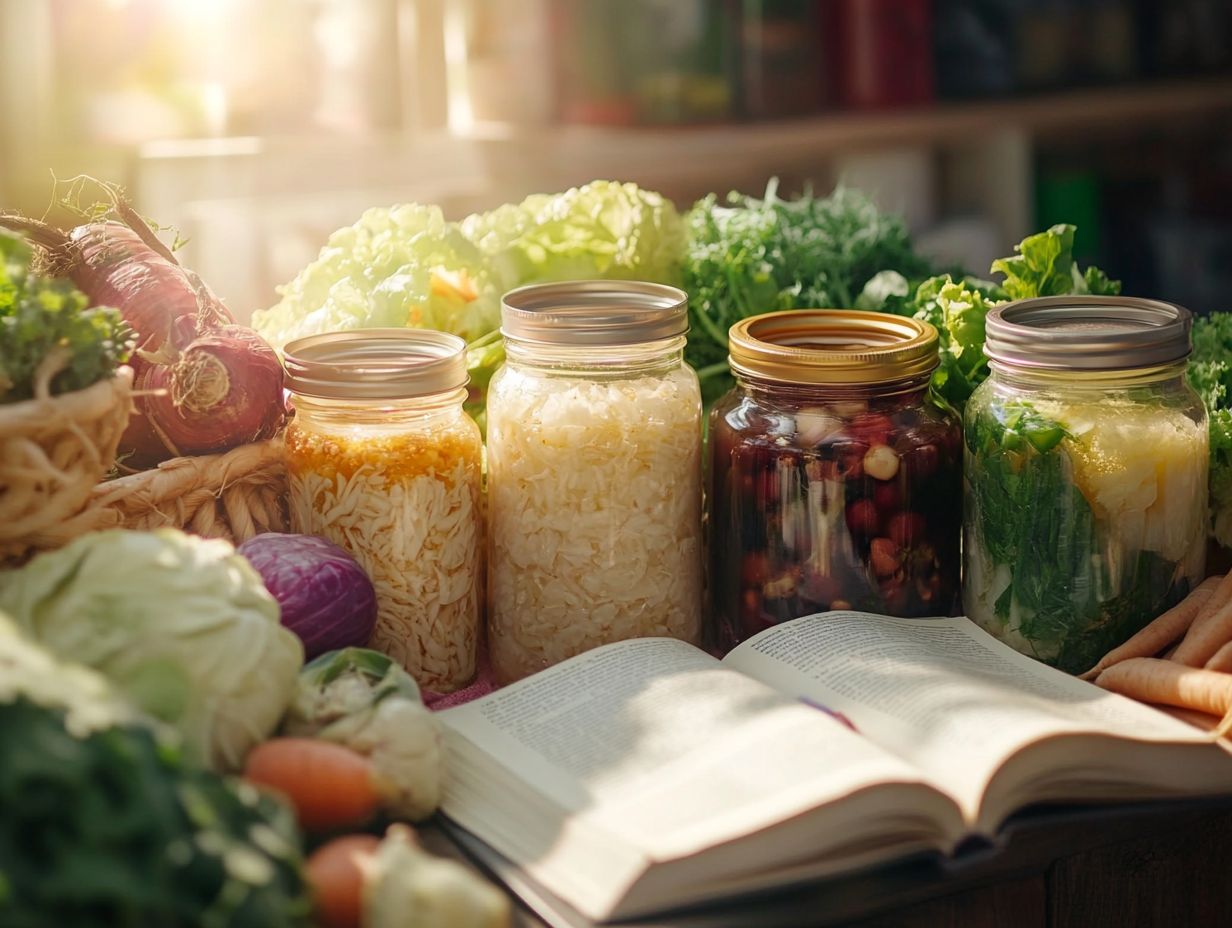
A fermentation vessel is your key to mastering the art of fermentation. This container is specially designed to create controlled conditions.
It allows gas to escape while keeping unwanted contaminants at bay. Choosing the right vessel is critical for achieving successful fermentation outcomes.
Louis Pasteur’s research played a significant role in understanding the importance of these controlled conditions.
Selecting the right fermentation vessel ensures that beneficial microorganisms thrive and that the entire process unfolds seamlessly.
When exploring fermentation vessels, you ll find a variety of types, each offering distinct advantages. Glass fermentation jars are a favorite for their inert properties and the ease with which you can observe the fermentation process.
On the other hand, plastic buckets are perfect for larger batches, boasting lightweight convenience, though they may come with the downside of scratches that can trap contaminants.
If you re considering clay and ceramic crocks, they strike an excellent balance between breathability and moisture retention, making them ideal for specific types of pickling. Just keep in mind that they can be a bit of a chore to clean.
Consider the size carefully to ensure your batch fits perfectly, and think about ease of cleaning and the vessel’s suitability for particular fermentation types, like brewing or making sauerkraut.
Ultimately, a thoughtfully chosen fermentation vessel not only nourishes the activity of beneficial microorganisms but also elevates the quality and consistency of your fermented creations.
What is a Fermentation Weight?
A fermentation weight is an invaluable tool for keeping your ingredients fully submerged during the fermentation process, especially when it comes to vegetables.
By ensuring they remain below the brine level, these weights help prevent exposure to air and potential spoilage. You ll find fermentation weights crafted from a variety of materials, including glass and ceramic, and they play a vital role in maintaining the anaerobic environment (an environment without oxygen) essential for successful fermentation.
When used correctly, fermentation weights can significantly enhance both the quality and safety of your final fermented product. Proper usage of these weights is key in fermentation troubleshooting.
For example, glass fermentation weights are often preferred for their non-reactive properties and sleek aesthetics, while ceramic options can add a touch of rustic charm to your process.
To use these weights effectively, you’ll want to select one that fits snugly into your fermentation vessel, ensuring that your veggies are adequately covered by the brine.
If you can t find commercial weights, don t worry DIY alternatives like clean rocks or water-filled mason jars can do the trick, provided they are properly sanitized beforehand.
Ultimately, keeping those ingredients submerged is crucial for preventing mold growth and achieving a successful fermentation every time.
What is a Fermentation Lid?
A fermentation lid is your key to achieving a successful fermentation process. Designed to fit snugly on your fermentation vessel, it allows gases generated during fermentation to escape while preventing contamination and maintaining those all-important anaerobic conditions (an environment without oxygen, which is crucial for fermentation). Many lids come with airlocks, enabling gas release without letting air sneak in, which is critical for the magic to happen. This process is especially important for fermenting beverages like wine, beer, and kombucha.
By using a proper fermentation lid, you enhance the safety of your process and contribute to the development of the rich flavors and textures that make fermented foods so delightful.
Choosing the Right Fermentation Lid
When you explore the selection of fermentation lids available on the market, you ll find a variety of designs and functionalities, including silicone grommets, bubbler airlocks, and solid lids crafted for different fermentation styles. Each type serves a specific purpose; for example, some are expertly designed for brewing beer, while others are perfect for crafting sauerkraut or kimchi.
As you choose your fermentation lid, don t forget to consider the type of fermentation you’re undertaking, the size of your vessel, and the expected duration of the process. Proper usage means regularly sanitizing the lid and ensuring it fits securely to minimize the risk of unwanted microorganisms.
This way, you allow the beneficial bacteria and yeasts to thrive, unimpeded by any unwelcome guests.
How to Start the Fermentation Process?
Embarking on the fermentation journey requires you to follow a few important steps, from selecting the finest ingredients to preparing them with precision, all while mastering the intricacies of the fermentation recipe for optimal results.
Diligently attending to each phase particularly temperature control and hygiene is vital for preventing contamination. This attention unlocks the full spectrum of flavors and health benefits.
Whether you re diving into the art of simple vegetable fermentation or tackling a more intricate dairy fermentation, equipping yourself with knowledge about potential troubleshooting can profoundly elevate your experience. Being aware of fermentation factors such as temperature and hygiene is essential for successful outcomes.
Now that you know how to choose and use a fermentation lid, it’s time to start your own delicious fermentation adventure!
What are the Steps for Fermenting Vegetables?
Vegetable fermentation typically involves several clear steps:
- Prepare the vegetables: Start by selecting high-quality vegetables. Make sure they are free from blemishes or spoilage.
- Submerge in brine: Prepare a brine solution to submerge the vegetables and create an anaerobic (oxygen-free) environment.
- Keep them in an anaerobic environment: This environment allows beneficial bacteria, such as Lactobacillus, to flourish and ferment the natural sugars.
- Monitor the fermentation process: Keep an eye on the fermentation, observing for bubbles or changes in aroma.
Understanding these steps will help you produce high-quality fermented foods consistently. The art of vegetable fermentation begins with selecting fresh ingredients. Prepare a brine solution to submerge the vegetables, creating an environment where beneficial cultures can thrive. This transformative process not only preserves your vegetables but also cultivates unique flavors and textures. You can create delightful dishes like kimchi and sauerkraut. Adhering to these fermentation steps is essential for achieving stellar results while ensuring fermentation safety.
Consider using fermentation weights to keep the vegetables submerged in the brine. The brine, a crucial mixture of water and salt in the right proportions, plays a pivotal role in the fermentation process. The right balance of salinity promotes beneficial bacteria while keeping undesirable molds at bay. This brine is essential for both vegetable and dairy fermentation, helping to create an environment where beneficial cultures can thrive.
The fermentation duration can vary depending on the type of vegetable and the level of tanginess you desire, typically ranging from a few days to several weeks. Regular monitoring is key; observe for the development of bubbles or any changes in aroma to ensure everything is progressing as it should. Remember, fermentation is a dynamic chemical process where microorganisms like yeast and bacteria convert sugars into organic compounds such as carbon dioxide and alcohol.
Mastering these steps results in delicious, probiotic-rich foods and enhances your culinary creativity. You can experiment and delight in your fermentation journey. From probiotic foods to fermented beverages like kombucha, the possibilities are endless.
What are the Steps for Fermenting Dairy?
Fermenting dairy is an art that involves precise steps:
- Select high-quality milk: Choose the best milk for your fermentation.
- Pasteurize if necessary: This step ensures that any harmful bacteria are eliminated.
- Inoculate the milk: Add beneficial cultures like Lactobacillus and yeast.
- Incubate at controlled temperatures: Maintain temperatures ideally between 110 F to 115 F for optimal fermentation.
Understanding the vital role of fermentation cultures is essential for anyone aspiring to craft delicious, flavorful dairy products at home. These cultures, typically a blend of beneficial bacteria and yeast, do more than just thicken the milk and impart unique flavors; they also boost the nutritional value by enhancing the availability of vitamins and minerals. Regularly consuming fermented dairy products like yogurt and kefir can improve gut microbiome health and provide substantial health benefits.
It’s crucial to keep a close eye on the fermentation duration, which can range from a few hours to overnight. Regularly enjoying fermented dairy offers a host of health benefits, including improved digestion, enhanced immunity, and a thriving environment for gut flora. This reinforces the importance of making these nutrient-rich foods a staple in your diet.
What are the Steps for Fermenting Grains?
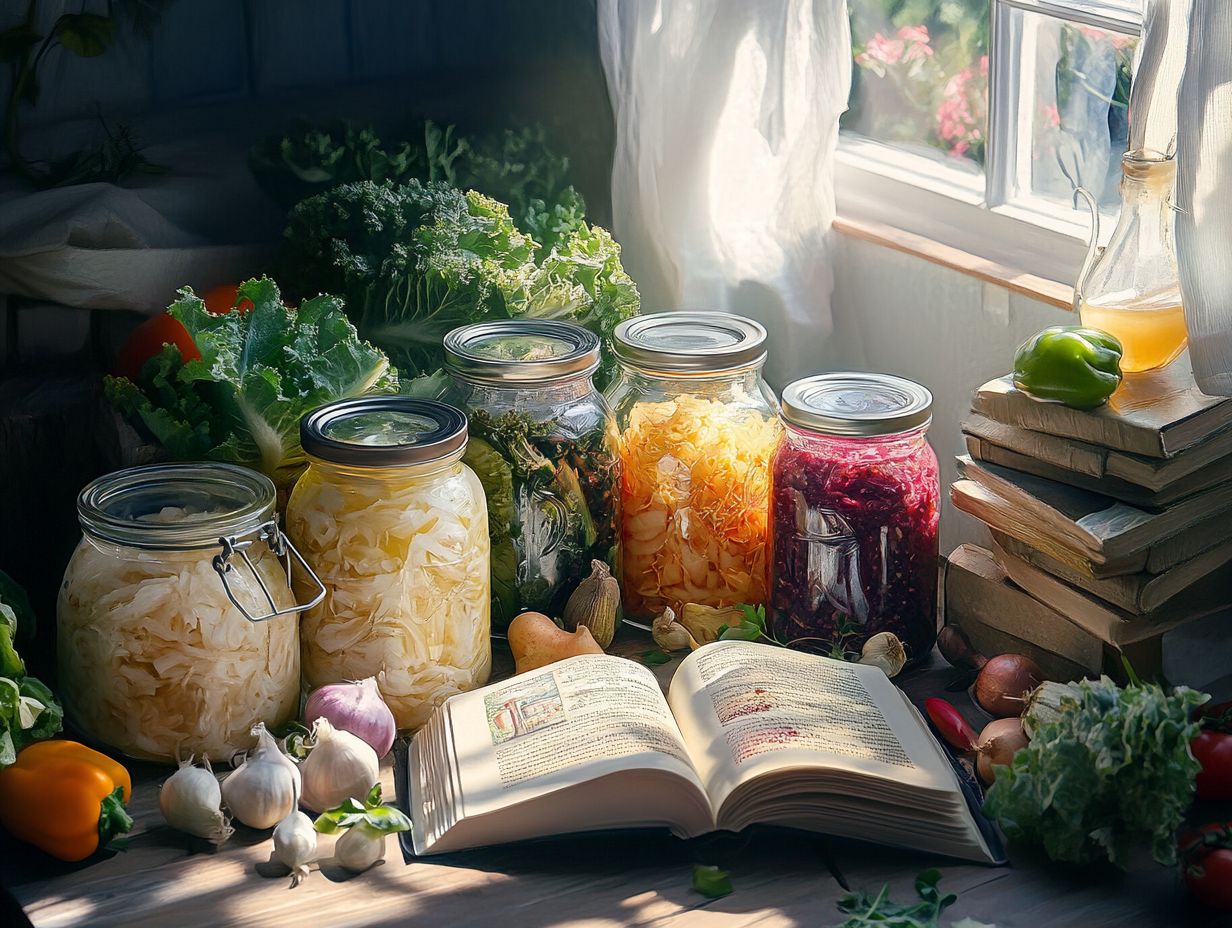
Fermenting grains is an art that unfolds in a series of deliberate steps, starting with soaking, cooking, or sprouting the grains to activate the beneficial microorganisms. Once you’ve done that, it’s time to introduce specific fermentation cultures, setting the stage for the transformation. This step is vital for crafting delicious and nutritious foods!
This meticulous process turns ordinary grains into nutritious treasures like miso and tempeh, enhancing both their flavors and nutritional value. By following the proper fermentation steps, you re not just ensuring a successful outcome; you re on your way to creating delicious, health-promoting foods brimming with probiotics.
To kick off the fermentation journey, begin by selecting the right grains lentils, soybeans, or barley and give them a thorough rinse to remove any impurities. Soaking the grains for several hours softens them, creating a hospitable environment for beneficial enzymes and bacteria.
Once soaked, a light cooking session will help eliminate any unwanted microorganisms. After cooking, allow the grains to cool before introducing the starter cultures, which might include delightful ingredients like koji mold (a type of mold used in fermentation) or specific lactic acid bacteria. This process helps produce a range of fermented products like miso, tempeh, and even beer.
This fermentation process boosts digestibility and enriches the grains with essential vitamins and minerals. This is how you end up with beloved dishes such as sourdough bread, fermented porridge, and even beer, each celebrated for their unique flavors and health benefits.
Watch this video to understand the fermentation process in home brewing better!
Frequently Asked Questions
What is fermentation and why is it important?
Fermentation is a natural process that breaks down carbohydrates in the absence of oxygen, resulting in the production of energy, alcohol, or acidic compounds. It is important because it is used to create products like beer, wine, cheese, yogurt, and bread. This anaerobic process also produces other organic compounds essential for the unique flavors of fermented foods.
What are the key steps in the fermentation process?
The key steps in the fermentation process include preparing a suitable environment for fermentation, adding microorganisms, converting carbohydrates, and collecting and storing the fermented product. Each of these fermentation steps is critical to producing high-quality fermented foods.
What are the different types of fermentation?
There are several types of fermentation, including alcoholic fermentation (used in the production of beer and wine), lactic acid fermentation (used in the production of yogurt and cheese), acetic acid fermentation (used in the production of vinegar), and butyric acid fermentation, which can occur in foods like butter and certain fermented vegetables.
Do different microorganisms affect the fermentation process?
Yes, the type of microorganism used in the fermentation process will have a significant impact on the final product. Each type of microorganism, such as yeast, Lactobacillus, and Acetobacter, has unique characteristics and can produce different flavors, textures, and aromas. For instance, Louis Pasteur’s studies on yeast have greatly advanced our understanding of fermentation microbiology.
How are temperature and duration important in fermentation?
Temperature and duration play crucial roles in the fermentation process. Different types of microorganisms thrive at different temperatures, and the duration of fermentation will affect the final product’s taste, texture, and alcohol content. Maintaining the right fermentation temperature ensures that beneficial microorganisms outcompete undesirable ones, leading to successful fermentation.
Is fermentation safe for consumption?
Yes, fermentation is safe for consumption. It has been used by humans for thousands of years to create food and beverages and is a natural and healthy way to preserve and enhance the flavor of certain foods. Understanding fermentation hygiene, such as using clean equipment and proper fermentation vessels, is essential to ensure food safety.



